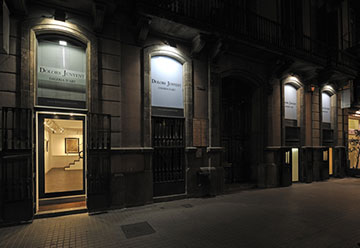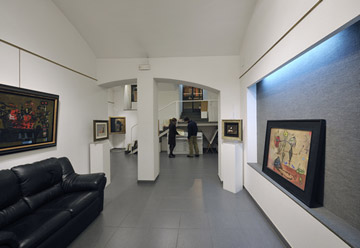- Amat, Frederic
- Amat, Gabriel
- Arranz Bravo
- Arroyo
- Barbara
- Barcelo
- Bartolozzi
- Bea
- Becquer
- Benet
- Bird
- Bores
- Brinkmann
- Brossa
- Cardenas
- Carral
- Casas
- Castillo
- Chancho
- Clave
- Corbero
- Corneille
- Croft
- Cuixart
- Domingo
- Fabres
- Farreras
- Feito
- Fenosa
- Forteza
- Genovart
- Gimeno
- Gonzalez
- Gonzalo
- Graner
- Granyer
- Grau
- Grau Sala
- Gudiol
- Guinovart
- Hernandez Mompo
- Hernandez Pijuan
- Jorn, Asger
- Junyent, Oleguer
- Lam
- Llena
- Lloveras
- Lopez Ramon
- Marin
- Marsans
- Marti Alsina
- Matilla
- Meifren
- Menchu Gal
- Meseguer
- Mir
- Mira
- Miro
- Moore
- Moragas
- Munoz
- Noland
- Olive
- Palazuelo
- Palencia
- Pazos
- Perejaume
- Perez Villalta
- Picasso
- Plasencia
- Plensa
- Ponç
- Puig
- Rafols Casamada
- Ramis
- Rasero
- Rebull
- Riera i Arago
- Rivera
- Roca Sastre
- Roig Soler
- Rossell
- Rueda
- Saura
- Serra
- Sicilia
- Solano
- Subirachs
- Sunyer
- Tamayo
- Tapies
- Tharrats
- Togores
- Torner
- Torres Garcia
- Ubeda
- Ucles
- Valdes
- Valls
- Vedova
- Viladecans
- Vilagrasa
- Zao Wou-ki
Artists +
Hours
Canogar
Painter, sculptor and abstract printmaker. Founder, along with other artists, of the group "El Paso". His work, with an informalist aesthetic, is the expression of freedom.
BIOGRAPHY OF RAFAEL G. CANOGAR:
Toledo 1935
Canogar is one of the most recognized Spanish contemporary painters and engravers; His works can be admired in the most important museums throughout the world. After spending his childhood in San Sebastián, in 1944 he moved to Madrid with his family. Four years later, the painter Vázquez Díaz accepted him as a disciple, and at the same time, he drew at the Círculo de Bellas Artes. At this time, he painted landscapes and portraits in the style of his teacher and began to be interested in the work of Braque, Picasso and Miró.
Around 1955, Canogar evolved towards informalist abstraction with a strong expressive charge. That year he met the critic M. Conde, with whom he traveled to Paris and Italy. In 1957, Canogar was a founding member of the informalist group El Paso, along with Manuel Millares, Antonio Saura, Luis Feito, Manuel Rivera, Pablo Serrano, Juana Frances and Antonio Suárez. In 1960, he participated in the New Spanish Painting and Sculpture exhibition at the Museum of Modern Art (MOMA) in New York, along with exponents of the young avant-garde.
At this time, he painted very gestural works in ocher, gray, white and black tones. That is when the series "Characters" begins with a timid intention of social criticism. Starting in the sixties, he introduced fragments of reportage photographs into his works and gradually the forms took shape in objects, faces and figures.
In 1964, he definitively abandoned informalism and began a stage based on the narrative chronicle of reality, inspired by the media, with a clear political criticism through images of riots and repression. Subsequently, these images acquire a third dimension and the colors are reduced to the range of grays and blacks. In 1966, he was invited as a visiting professor at Mills College in Oakland (California).
Starting in 1975, Canogar returned to abstraction, incorporating formal elements from the Cubist tradition and shortly after moving on to monochrome paintings made from interwoven brushstrokes. Since the beginning of the eighties, he has focused his interest on the subject of still lifes, "The Heads" by Julio González and urban scenes, combining color planes and schematic figures. In 1971, he won the Grand Prize at the Sao Paulo Biennial and in 1982, the National Prize for Plastic Arts.




